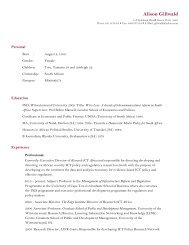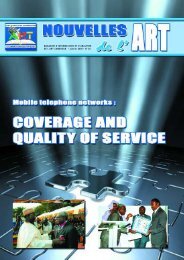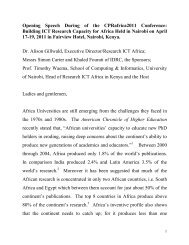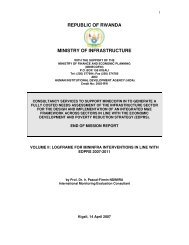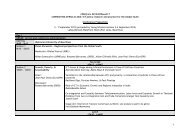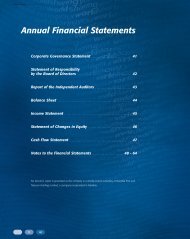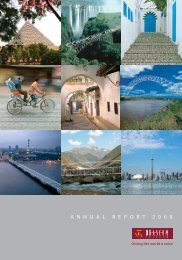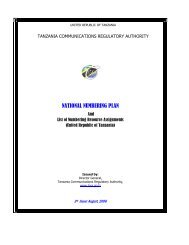Zambia ICT Sector Performance Review 2010 - Research ICT Africa
Zambia ICT Sector Performance Review 2010 - Research ICT Africa
Zambia ICT Sector Performance Review 2010 - Research ICT Africa
You also want an ePaper? Increase the reach of your titles
YUMPU automatically turns print PDFs into web optimized ePapers that Google loves.
<strong>Zambia</strong> <strong>ICT</strong> <strong>Sector</strong> <strong>Performance</strong> <strong>Review</strong> 2009/<strong>2010</strong><br />
Table 8: Number of VSATs Licensed<br />
Year<br />
Number of VSATs licensed<br />
2004 9<br />
2005 24<br />
2006 23<br />
2007 103<br />
2008 11<br />
2009 24<br />
The above figures do not take into account the number of direct VSAT links that provide the only<br />
form of Internet access, particularly in rural areas. The table below shows the number of VSAT<br />
licenses issued annually. This does not include a significant number of VSATs that are not licensed<br />
by the regulator.<br />
The increasing growth of broadband Internet, as evidenced by the growth in broadband<br />
subscribers and usage of VSATs, strongly suggests that there is increased Internet utilization among<br />
corporates and small and medium enterprises. This is supported by the continuing growth of<br />
Africonnect – a WIMAX ISP that has become the first ISP in <strong>Zambia</strong> to establish Point of Presence in<br />
all provincial administrative and key business centers. In May <strong>2010</strong>, Africonnect was in negotiation<br />
to be acquired by Vodacom 25 .<br />
Probably the growth trends in bandwidth usage provide a better proxy for measuring internet<br />
growth. As shown in the table below, total bandwidth usage has on average grown six-fold in the<br />
four year period, between 2005–2008. This is despite the high cost of satellite connectivity that<br />
most ISPs are using due to lack of or limited access to affordable terrestrial optic fiber internet links.<br />
Table 9: Bandwidth Usage (Mbps)<br />
Year<br />
Outgoing (Mbps)<br />
Bandwidth Usage<br />
Incoming(Mbps)<br />
2004 8.76 20.316<br />
2005 10.096 24.408<br />
2006 34.79 79.884<br />
2007 46.478 119.96<br />
2008 48.834 197.523<br />
Despite a growing demand for broadband internet, the majority of <strong>Zambia</strong>ns are unable to make<br />
individual subscriptions due to high retail costs of the service brought about by the high<br />
infrastructure investment costs including high cost of bandwidth and internet access fees.<br />
Schedule of Revenues for ISPs in ZMK (Millions)<br />
ISP 2009 2008 2007 2006<br />
AFRICONNECT 22,845 15,232 8,800 4,362<br />
MICROLINK TECHNOLOGIES 12,087 9,619 7,650 4,142<br />
ZAMNET 17,218 12,585 9,263 9,258<br />
PRONET AFRICA 4,963 3,185 2,750 3,229<br />
REAL TIME N/A 6,405 3,063 166<br />
COPPERNET SOLUTIONS N/A 14,247 11,326 10,417<br />
UUNET ZAMBIA N/ A 7,697 5,960 5,728<br />
QUICK EDGE 1,835 1,132 1,158 745<br />
BRINGCOM N/A 1,216<br />
Source: Z<strong>ICT</strong>A<br />
Despite a growing<br />
demand for<br />
broadband internet,<br />
the majority of<br />
<strong>Zambia</strong>ns are unable<br />
to subscribe to Internet<br />
services due to high<br />
access fees<br />
25 Postscript: Africonnect has since been acquired by Vodacom Business <strong>Africa</strong><br />
17



